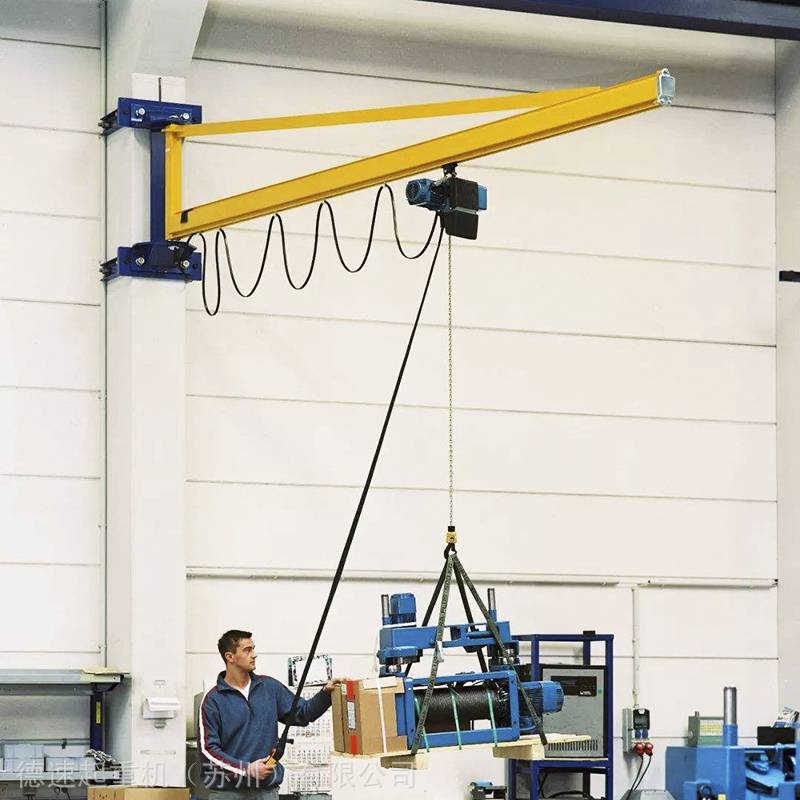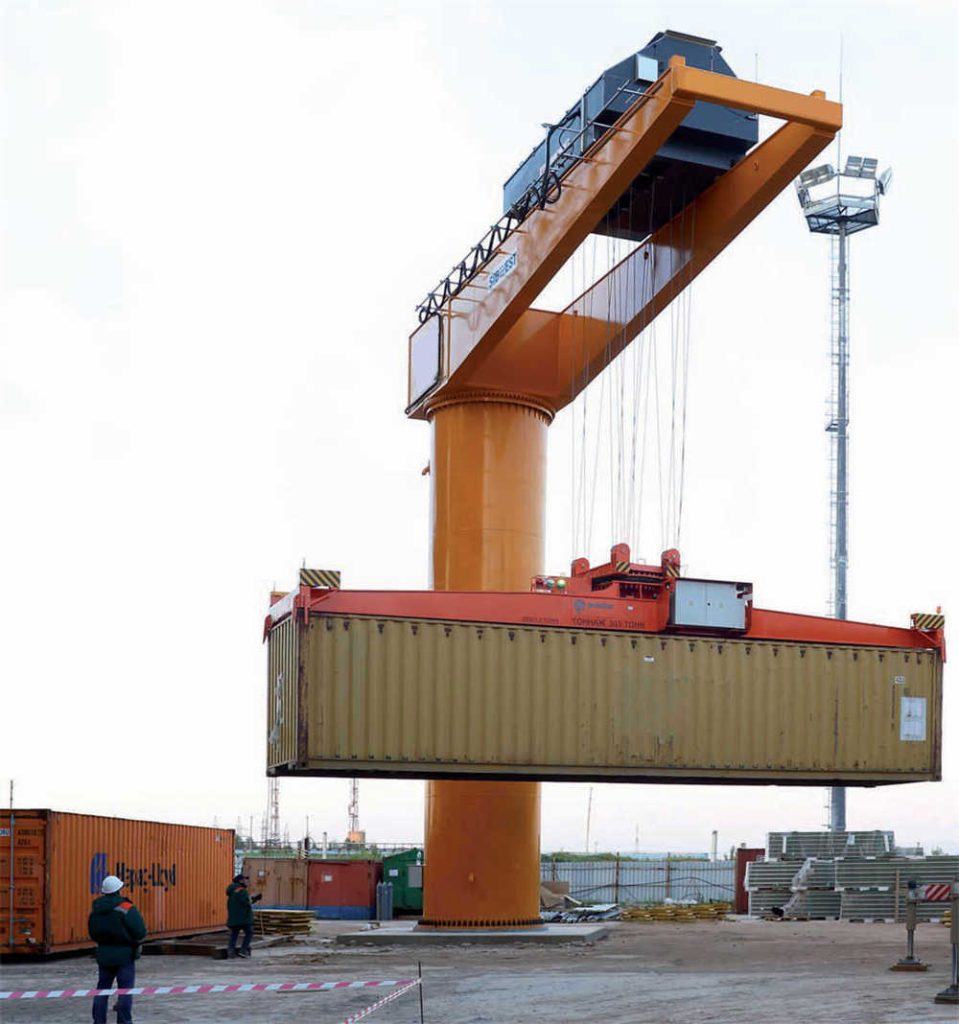Workshop Jib Crane
Introduction to Workshop Jib Cranes
A Workshop Jib Crane is a versatile lifting device designed for material handling in small workshops, warehouses, and industrial facilities. It consists of a vertical mast (or mounting structure), a horizontal boom (jib arm), and a lifting mechanism such as an electric hoist or manual chain block. Unlike larger overhead cranes, jib cranes are compact, space-efficient, and ideal for localized lifting tasks.
Key Functions and Benefits
- Efficient Material Handling: Enables easy lifting and positioning of heavy loads within a limited workspace.
- Space-Saving Design: Requires minimal floor space compared to gantry or bridge cranes.
- Flexible Operation: The rotating boom (typically 180° to 360°) allows precise load placement.
- Improved Productivity: Reduces manual labor and speeds up workflow in assembly, maintenance, and manufacturing processes.
Common Applications
- Mechanical Workshops: Lifting engines, gearboxes, and heavy machinery parts.
- Assembly Lines: Positioning components during production.
- Warehouses & Logistics: Loading/unloading goods in tight spaces.
- Repair & Maintenance Shops: Handling heavy equipment for servicing.
Types of Workshop Jib Cranes
1. Wall-Mounted Jib Crane
The wall-mounted jib crane is fixed to an existing wall or structural column, making it ideal for workshops with limited floor space. Its boom typically rotates 180° or 270°, providing sufficient coverage along a wall or workstation.
Key Features:
- Space-Efficient: Does not require floor support, freeing up workspace.
- Load Capacity: Usually ranges from 250 kg (0.25 tons) to 5 tons.
- Installation Requirements: Requires a strong, load-bearing wall (concrete or steel preferred).
Best For:
- Small workshops with sturdy walls.
- Assembly stations where materials need to be moved along a fixed path.
- Maintenance areas where floor space is limited.

2. Floor-Mounted Jib Crane
The floor-mounted jib crane is a freestanding system anchored to a concrete foundation. It offers 360° rotation, providing full coverage around the mast.
Key Features:
- Full Rotation: Allows unrestricted movement for maximum flexibility.
- Higher Load Capacity: Supports weights from 0.5 tons up to 10+ tons.
- Sturdy Construction: Requires a reinforced concrete base for stability.
Best For:
- Heavy-duty industrial applications (e.g., steel fabrication, machinery handling).
- Central workstations where loads need to be moved in all directions.
- Large workshops where wall mounting is not feasible.

3. Portable Jib Crane
The portable jib crane (also called a mobile jib crane) features a wheeled base, allowing it to be moved easily between workstations.
Key Features:
- Mobility: Equipped with heavy-duty casters (some with locking mechanisms).
- Light to Medium Duty: Typically handles 250 kg to 2 tons.
- Quick Setup: No permanent installation required.
Best For:
- Temporary job sites or repair workshops.
- Facilities requiring flexible lifting solutions (e.g., automotive garages).
- Small warehouses where fixed cranes are impractical.

Key Selection Factors for Workshop Jib Cranes
Load Capacity (0.5 to 10 Tons)
The load capacity is undoubtedly the most critical specification when choosing a workshop jib crane. These cranes are available in a wide range of capacities from modest 0.5-ton models to heavy-duty 10-ton versions. For automotive workshops handling engine blocks, a 1-2 ton capacity typically suffices, while metal fabrication shops working with large steel components may require 5-ton or greater capacity.
It’s essential to consider both static and dynamic loads in your calculations. Industry experts recommend selecting a crane with at least 25% more capacity than your heaviest anticipated load to account for:
- Potential load variations
- Shock loading during movement
- Future business expansion needs
Rotation Flexibility (180°, 270°, or 360°)
The rotation angle significantly impacts operational efficiency:
- 180° rotation models are space-efficient for wall-mounted installations where full rotation isn’t necessary
- 270° rotation cranes offer extended coverage while still maintaining structural stability
- 360° rotation provides complete circular access but requires careful consideration of the support structure
For maximum productivity in busy workshops, many operators prefer 360° rotating models with electric rotation systems that allow precise positioning at the push of a button.
Boom Length (2-6 Meters)
Boom length determines your working envelope:
- Short booms (2-3m) are ideal for compact work cells
- Medium booms (4-5m) suit most general workshop applications
- Long booms (6m+) are used in large assembly areas
Remember that longer booms reduce the crane’s effective capacity due to increased moment forces. Always consult load charts that account for both boom length and angle.
Construction Materials
The choice between steel and aluminum construction involves important tradeoffs:
Steel Jib Cranes:
- Superior strength for heavy loads
- Greater durability in harsh environments
- More cost-effective for high-capacity applications
- Heavier weight requires more robust support
Aluminum Jib Cranes:
- 30-40% lighter than equivalent steel models
- Excellent corrosion resistance
- Easier to reposition if needed
- Higher initial cost but lower lifetime maintenance

Industry-Specific Applications
Automotive Repair Shops
Jib cranes have revolutionized engine servicing:
- Safely lift and position engines during removal/installation
- Allow precise alignment during transmission work
- Enable single-person operation of heavy components
- Reduce workplace injuries from manual handling
Leading repair shops often choose 1-ton capacity, 270° rotation models with 4m booms – the perfect balance of power and maneuverability for most vehicle sizes.
Small-Scale Manufacturing
In manufacturing environments, jib cranes:
- Facilitate quick die changes in press operations
- Enable safe handling of heavy molds
- Improve ergonomics in assembly processes
- Reduce product damage during material transfer
Many facilities opt for floor-mounted 360° models near key workstations, with capacities matched to their heaviest production components.
Warehouse and Logistics Operations
Modern warehouses utilize jib cranes to:
- Assist with truck loading/unloading
- Handle awkwardly shaped items
- Work in conjunction with forklifts for precision placement
- Operate in narrow aisles where larger cranes can’t access
Portable jib cranes are particularly valuable in distribution centers, allowing equipment to be moved to where it’s needed most.
Frequently Asked Questions
Can Workshop Jib Cranes Be Customized?
Absolutely. Dongqi Crane offer numerous customization options:
- Boom lengths tailored to your facility
- Powder-coating in any RAL color for corporate branding
- Electric rotation systems for precise control
- Specialized lifting attachments (hooks, magnets, grabs)
- Weatherproofing for outdoor use
- Collapsible designs for low-clearance areas
What’s the Recommended Maintenance Schedule?
Proper maintenance ensures safety and longevity:
Monthly:
- Lubricate all pivot points and rotation bearings
- Inspect wire ropes/straps for wear
- Check for loose fasteners
- Examine structural components for cracks/deformation
Annually:
- Complete load testing (recommended)
- Professional inspection of all critical components
- Electrical system check (for powered models)
- Paint touch-up to prevent corrosion
After 5 Years:
- Consider replacing wear components
- Complete structural integrity assessment
- Potential upgrade to newer safety features
Conclusion
Workshop jib cranes represent one of the most cost-effective material handling solutions for small to medium-sized operations. Their combination of affordability, flexibility, and reliability makes them indispensable in countless industrial settings.
When selecting your ideal jib crane:
- Carefully assess your load requirements and growth potential
- Map your workspace to determine optimal boom length and rotation
- Consider future flexibility needs (portability, reconfiguration)
- Factor in total cost of ownership, not just purchase price
Modern jib cranes offer remarkable versatility – from basic manual models starting around $1,500 to sophisticated electric systems at $15,000+. By matching the crane’s capabilities to your specific operational needs, you’ll achieve the perfect balance of performance and value.
For operations requiring frequent heavy lifting, investing in a quality jib crane typically pays for itself within 12-18 months through reduced labor costs, fewer workplace injuries, and improved productivity. Consult with an experienced material handling specialist to ensure you select the ideal configuration for your workshop’s unique requirements.ommendations on specific brands or installation tips? Let us know in the comments!
